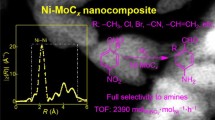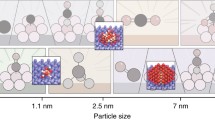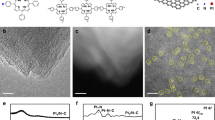Abstract
Catalytic hydrogenation is a vital industrial means to produce value-added fuels and fine chemicals, however, requiring highly efficient catalysts, especially the nonprecious ones. To date, the majority of high-performance industrial hydrogenation catalysts are made of precious metals-based materials, and any given catalyst could only be used to catalyze one or few specific reactions. Herein, we exemplify a crystal phase engineering approach to empower Ni nanoparticles (NPs) with superb intrinsic catalytic activities toward a wide spectrum of hydrogenation reactions. A facile pyrolysis approach is used to directly convert a Ni-imidazole MOF precursor into hexagonal close-packed (hcp)-phased Ni NPs on carbon support. The as-synthesized hcp-phased Ni NPs exhibit unprecedented hydrogenation catalytic activities in pure water towards nitro-, aldehyde-, ketone-, alkene- and N heterocyclic-compounds, outperforming the face-centered cubic (fcc)-Ni counterpart and the reported transition metals-based catalysts. The density functional theory calculations unveil that the presence of hcp-Ni boosts the intrinsic catalytic hydrogenation activity by coherently enhancing the substrate adsorption strength and lowering the reaction barrier energy of the rate-determining step. We anticipate that the crystal phase engineering design approach unveiled in this work would be adoptable to other types of reactions.
摘要
催化加氢是生产高附加值燃料和精细化学品的重要工业途径, 但需要高效的催化剂, 尤其是廉价的非贵金属催化剂. 迄今为止, 大多 数高性能催化加氢催化剂都是由贵金属材料制成, 并且这些催化剂都 只能用于催化一种或几种特定的反应. 在这里, 我们例证了一种晶相工 程方法, 其能赋予Ni纳米颗粒(NPs)卓越的、广谱的内在催化加氢活性. 这种负载于碳载体上含有hcp晶相的Ni NPs催化剂通过直接碳化热解 Ni咪唑MOF前驱体获得. 在纯水中, 含hcp相的Ni NPs对硝基、醛、 酮、烯烃和N杂环化合物表现出前所未有的加氢催化活性, 优于类似 物fcc-Ni和目前报道的其他过渡金属催化剂. 密度泛函理论计算表明, hcp-Ni通过增**底物吸附**度和降低速率决定步骤的反应势垒能共同 来提高内在催化氢化活性. 我们预计这项工作中揭示的晶相工程设计 方法将适用于其他类型的反应.
Similar content being viewed by others
References
Yang H, Bradley SJ, Chan A, et al. Catalytically active bimetallic nanoparticles supported on porous carbon capsules derived from metal-organic framework composites. J Am Chem Soc, 2016, 138: 11872–11881
Macino M, Barnes AJ, Althahban SM, et al. Tuning of catalytic sites in Pt/TiO2 catalysts for the chemoselective hydrogenation of 3-nitrostyrene. Nat Catal, 2019, 2: 873–881
Gong W, Lin Y, Chen C, et al. Nitrogen-doped carbon nanotube confined Co-Nx sites for selective hydrogenation of biomass-derived compounds. Adv Mater, 2019, 31: 1808341
Zhang L, Zhou M, Wang A, et al. Selective hydrogenation over supported metal catalysts: from nanoparticles to single atoms. Chem Rev, 2020, 120: 683–733
Formenti D, Ferretti F, Scharnagl FK, et al. Reduction of nitro compounds using 3d-non-noble metal catalysts. Chem Rev, 2019, 119: 2611–2680
Tian S, Hu M, Xu Q, et al. Single-atom Fe with Fe1N3 structure showing superior performances for both hydrogenation and transfer hydrogenation of nitrobenzene. Sci China Mater, 2020, 64: 642–650
Wang Y, Xu A, Wang Z, et al. Enhanced nitrate-to-ammonia activity on copper-nickel alloys via tuning of intermediate adsorption. J Am Chem Soc, 2020, 142: 5702–5708
Tang F, Wang L, Dessie Walle M, et al. An alloy chemistry strategy to tailoring the d-band center of Ni by Cu for efficient and selective catalytic hydrogenation of furfural. J Catal, 2020, 383: 172–180
Wang P, Shao Q, Cui X, et al. Hydroxide-membrane-coated Pt3Ni nanowires as highly efficient catalysts for selective hydrogenation reaction. Adv Funct Mater, 2018, 28: 1705918
Liu Y, Liu X, Feng Q, et al. Intermetallic NixMy (M = Ga and Sn) nanocrystals: a non-precious metal catalyst for semi-hydrogenation of alkynes. Adv Mater, 2016, 28: 4747–4754
Gong W, Yuan Q, Chen C, et al. Liberating N-CNTs confined highly dispersed Co-N sites for selective hydrogenation of quinolines. Adv Mater, 2019, 31: 1906051
Wang D, Al-Mamun M, Gong W, et al. Converting Co2+-impregnated g-C3N4 into N-doped CNTs-confined Co nanoparticles for efficient hydrogenation rearrangement reactions of furanic aldehydes. Nano Res, 2021, 14: 2846–2852
Mateen M, Shah K, Chen Z, et al. Selective hydrogenation of N-heterocyclic compounds over rhodium-copper bimetallic nanocrystals under ambient conditions. Nano Res, 2019, 12: 1631–1634
**ao Q, Sarina S, Waclawik ER, et al. Alloying gold with copper makes for a highly selective visible-light photocatalyst for the reduction of nitroaromatics to anilines. ACS Catal, 2016, 6: 1744–1753
Petró J, Bóta A, László K, et al. A new alumina-supported, not pyrophoric Raney-type Ni-catalyst. Appl Catal A-Gen, 2000, 190: 73–86
Zhou Y, gao Y, Zhong X, et al. Electrocatalytic upgrading of lignin-derived bio-oil based on surface-engineered PtNiB nanostructure. Adv Funct Mater, 2019, 29: 1807651
Ni J, Leng W, Mao J, et al. Tuning electron density of metal nickel by support defects in Ni/ZrO2 for selective hydrogenation of fatty acids to alkanes and alcohols. Appl Catal B-Environ, 2019, 253: 170–178
Khan NA, Chen JG. Correlating mechanical strain with low-temperature hydrogenation activity on submonolayer Ni/W(110) surfaces. J Phys Chem B, 2003, 107: 4334–4341
Crespo-Quesada M, Yarulin A, ** M, et al. Structure sensitivity of alkynol hydrogenation on shape- and size-controlled palladium nanocrystals: which sites are most active and selective? J Am Chem Soc, 2011, 133: 12787–12794
Lv Y, Han M, Gong W, et al. Fe-Co alloyed nanoparticles catalyzing efficient hydrogenation of cinnamaldehyde to cinnamyl alcohol in water. Angew Chem Int Ed, 2020, 59: 23521–23526
Han M, Liu Q, He J, et al. Controllable synthesis and magnetic properties of cubic and hexagonal phase nickel nanocrystals. Adv Mater, 2007, 19: 1096–1100
Zhang C, Yang J, Liu Y, et al. Catalytic hydrogenation of nitrophenols by cubic and hexagonal phase unsupported Ni nanocrystals. ChemistrySelect, 2019, 4: 42–48
Wegner S, Rutz C, Schütte K, et al. Soft, wet-chemical synthesis of metastable superparamagnetic hexagonal close-packed nickel nanoparticles in different ionic liquids. Chem Eur J, 2017, 23: 6330–6340
Gao X, Zhu S, Dong M, et al. MOF-derived hcp-Co nanoparticles encapsulated in ultrathin graphene for carboxylic acids hydrogenation to alcohols. J Catal, 2021, 399: 201–211
Li N, Tan H, Ding X, et al. Phase-mediated robust interfacial electron-coupling over core-shell Co@carbon towards superior overall water splitting. Appl Catal B-Environ, 2020, 266: 118621–118628
Yun Q, Lu Q, Li C, et al. Synthesis of PdM (M = Zn, Cd, ZnCd) nanosheets with an unconventional face-centered tetragonal phase as highly efficient electrocatalysts for ethanol oxidation. ACS Nano, 2019, 13: 14329–14336
Chen Y, Lai Z, Zhang X, et al. Phase engineering of nanomaterials. Nat Rev Chem, 2020, 4: 243–256
LaGrow AP, Cheong S, Watt J, et al. Can polymorphism be used to form branched metal nanostructures? Adv Mater, 2013, 25: 1552–1556
Zhang C, Guo X, Yuan Q, et al. Ethyne-reducing metal-organic frameworks to control fabrications of core/shell nanoparticles as catalysts. ACS Catal, 2018, 8: 7120–7130
Su J, Yang Y, **a G, et al. Ruthenium-cobalt nanoalloys encapsulated in nitrogen-doped graphene as active electrocatalysts for producing hydrogen in alkaline media. Nat Commun, 2017, 8: 14969–14979
Cheng H, Yang N, Lu Q, et al. Syntheses and properties of metal nanomaterials with novel crystal phases. Adv Mater, 2018, 30: 1707189
Kresse G, Furthmüller J. Efficient iterative schemes for ab initio total-energy calculations using a plane-wave basis set. Phys Rev B, 1996, 54: 11169–11186
Kresse G, Furthmüller J. Efficiency of ab-initio total energy calculations for metals and semiconductors using a plane-wave basis set. Comput Mater Sci, 1996, 6: 15–50
Perdew JP, Burke K, Ernzerhof M. Generalized gradient approximation made simple. Phys Rev Lett, 1996, 77: 3865–3868
Ernzerhof M, Scuseria GE. Assessment of the Perdew-Burke-Ernzerhof exchange-correlation functional. J Chem Phys, 1999, 110: 5029–5036
Grimme S. Semiempirical GGA-type density functional constructed with a long-range dispersion correction. J Comput Chem, 2006, 27: 1787–1799
Henkelman G, Uberuaga BP, Jónsson H. A climbing image nudged elastic band method for finding saddle points and minimum energy paths. J Chem Phys, 2000, 113: 9901–9904
Henkelman G, Jónsson H. Improved tangent estimate in the nudged elastic band method for finding minimum energy paths and saddle points. J Chem Phys, 2000, 113: 9978–9985
Wu JX, Yuan WW, Xu M, et al. Ultrathin 2D nickel zeolitic imidazolate framework nanosheets for electrocatalytic reduction of CO2. Chem Commun, 2019, 55: 11634–11637
Chen Z, Yang W, Wu Y, et al. Atomic iron on mesoporous N-doped carbon to achieve dehydrogenation reaction at room temperature. Nano Res, 2020, 13: 3075–3081
Zhang H, Liu Y, Chen T, et al. Unveiling the activity origin of electrocatalytic oxygen evolution over isolated Ni atoms supported on a N-doped carbon matrix. Adv Mater, 2019, 31: 1904548
Rui K, Zhao G, Chen Y, et al. Hybrid 2D dual-metal-organic frameworks for enhanced water oxidation catalysis. Adv Funct Mater, 2018, 28: 1801554
Wang C, Yang H, Zhang Y, et al. NiFe alloy nanoparticles with hcp crystal structure stimulate superior oxygen evolution reaction electrocatalytic activity. Angew Chem Int Ed, 2019, 58: 6099–6103
Zhu Y, Sun W, Chen W, et al. Scale-up biomass pathway to cobalt single-site catalysts anchored on N-doped porous carbon nanobelt with ultrahigh surface area. Adv Funct Mater, 2018, 28: 1802167
Chen S, Feng Y, Wang J, et al. Free-standing N-doped hollow carbon fibers as high-performance anode for potassium ion batteries. Sci China Mater, 2020, 64: 547–556
Lu Q, Yu J, Zou X, et al. Self-catalyzed growth of Co, N-codoped CNTs on carbon-encased CoSx surface: A noble-metal-free bifunctional oxygen electrocatalyst for flexible solid Zn-air batteries. Adv Funct Mater, 2019, 29: 1904481
Corma A, Concepción P, Serna P. A different reaction pathway for the reduction of aromatic nitro compounds on gold catalysts. Angew Chem Int Ed, 2007, 46: 7266–7269
Song T, Ren P, Duan Y, et al. Cobalt nanocomposites on N-doped hierarchical porous carbon for highly selective formation of anilines and imines from nitroarenes. Green Chem, 2018, 20: 4629–4637
Yang W, Liu X, Yue X, et al. Bamboo-like carbon nanotube/Fe3C nanoparticle hybrids and their highly efficient catalysis for oxygen reduction. J Am Chem Soc, 2015, 137: 1436–1439
He L, Weniger F, Neumann H, et al. Synthesis, characterization, and application of metal nanoparticles supported on nitrogen-doped carbon: catalysis beyond electrochemistry. Angew Chem Int Ed, 2016, 55: 12582–12594
Zhou X, Zhao H, Liu S, et al. Engineering nano-ordered of Ni nanoparticles on KIT-6 for enhanced catalytic hydrogenation of nitrobenzene. Appl Surf Sci, 2020, 525: 146382–146390
Meng X, Cheng H, Akiyama Y, et al. Selective hydrogenation of nitrobenzene to aniline in dense phase carbon dioxide over Ni/γ-Al2O3: Significance of molecular interactions. J Catal, 2009, 264: 1–10
Westerhaus FA, Jagadeesh RV, Wienhöfer G, et al. Heterogenized cobalt oxide catalysts for nitroarene reduction by pyrolysis of molecularly defined complexes. Nat Chem, 2013, 5: 537–543
Sun Q, Wang N, Zhang T, et al. Zeolite-encaged single-atom rhodium catalysts: Highly-efficient hydrogen generation and shape-selective tandem hydrogenation of nitroarenes. Angew Chem Int Ed, 2019, 58: 18570–18576
Sheng T, Qi YJ, Lin X, et al. Insights into the mechanism of nitrobenzene reduction to aniline over Pt catalyst and the significance of the adsorption of phenyl group on kinetics. Chem Eng J, 2016, 293: 337–344
Cheong WC, Yang W, Zhang J, et al. Isolated iron single-atomic sitecatalyzed chemoselective transfer hydrogenation of nitroarenes to arylamines. ACS Appl Mater Interfaces, 2019, 11: 33819–33824
Acknowledgements
This work was financially supported by the National Natural Science Foundation of China (51902311 and 51871209).
Author information
Authors and Affiliations
Contributions
Lv Y carried out the materials fabrication, characterizations and performance measurements, and wrote the initial manuscript; Mao X and Du A performed and guided theoretical analysis; Wang D, Chen C and Lin Y did some characterizations; Liu P, Wang G and Zhang H performed some data analysis; Gong W and Zhao H conceived and supervised this study, and revised the manuscript. All authors contributed to the general discussion.
Corresponding authors
Additional information
Conflict of interest
The authors declare that they have no conflict of interest.
Supplementary information
Experimental details and supporting data are available in the online version of the paper.
Yang Lv received his MSc degree from the University of Science and Technology of China. He is working on the synthesis of novel nanomaterials for catalytic reactions.
**n Mao is now a PhD student under Prof. Aijun Du’s supervision at the School of Chemistry and Physics, Queensland University of Technology. His research interest mainly focuses on computational design of some nonprecious metal-based materials for energy conversion and storage processes, such as hydrogen evolution reactions, oxygen evolution/reduction reactions, and CO2 reduction reactions.
Wanbing Gong received his PhD degree from the University of Science and Technology of China in 2018. Then, he joined Hefei Institutes of Physical Science, Chinese Academy of Sciences as a postdoctor. He took a Research Associate Professor position at the University of Science and Technology of China in 2021. His current research interests focus on searching for new nonprecious catalytic materials and novel catalytic systems to meet the need of industries.
Aijun Du obtained his PhD in nuclear and particle physics (2002) from Fudan University, China. He worked at Australian Institute for Bioengineering and Nanotechnology, University of Queensland for nine years. He joined Queensland University of Technology in 2013 as an Associate Professor and was promoted to a full Professor in 2017. His research focuses on the development of innovative nanomaterials for clean energy, environmental and nanoelectronics applications.
Huijun Zhao obtained his PhD in chemistry (1994) from the University of Wollongong, Australia, and subsequently held Research Fellow/Senior Research Fellow positions at the University of Wollongong and University of Western Sydney. He took a Lecturer position at Griffith University and was promoted to Chair Professor of chemistry (2005). One of his current pursuits is to explore new means to unlock the catalytic powers of nonprecious materials for important reactions.
Electronic Supplementary Material
Rights and permissions
About this article
Cite this article
Lv, Y., Mao, X., Gong, W. et al. hcp-phased Ni nanoparticles with generic catalytic hydrogenation activities toward different functional groups. Sci. China Mater. 65, 1252–1261 (2022). https://doi.org/10.1007/s40843-021-1860-x
Received:
Accepted:
Published:
Issue Date:
DOI: https://doi.org/10.1007/s40843-021-1860-x




